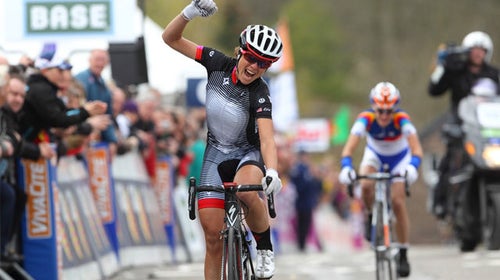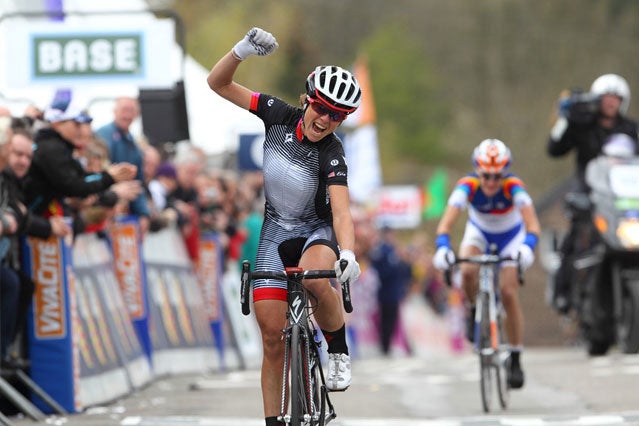There is an American in pink, but nobody cares. Not that that's anything new.
The is the biggest race you’ve never heard of. Covering 961.4 kilometers of Italian countryside over nine days, 127 athletes compete for one of the sport’s biggest prizes—the pink jersey. And in 2010, an American won it all. But as is usual for women’s cycling, the coverage was muted.
Again in 2012, American cyclists should be in the news: Evelyn Stevens became only the second American—after Lance Armstrong—to win the spring classic Fleche Wallone. She also recently won a stage at the Giro d’Italia Femminile. And is a favorite to defend her gold medal in the time trial at the London Olympics. There’s even a new race on the map: The , a women’s only stage race with $100,000 on the line. But for some reason, nobody seems to notice.
Throughout history, women have been deterred from competing in sports. The first woman to run the Boston Marathon as a numbered entry made headlines worldwide after her boyfriend shoved aside a race official who was berating her. And that was in 1967. Only in 1981—14 years later—did the International Olympic Committee welcome its first female member (today, 16 of 107 are women).
But things have improved. �´dz����’s tennis has strong ratings and is often more riveting than men’s tennis. Fans tune in across the globe to watch women’s soccer at the Olympics. And the WNCAA championship reaches over three million U.S. households. On the 40th anniversary of Title IX, there is hope.
When it comes to cycling, though, hope isn’t the first thing to pop into mind. Lance Armstrong, the sport’s icon, has fallen in recent years due to allegations of doping. Sponsors come and go at a frightening pace, and sustainability is tough. The Tour may be broadcast in 180 countries, but teams—despite their multi-million dollar budgets—don’t get a chunk of that money. They rely solely on the companies plastered across their jerseys (hence the frantic zipping-up at the finish line). In a single season, the sport’s most successful team can fold if a sponsor backs out. It happens often.
Meanwhile, women’s teams operate on the fringe—out of the limelight as the secondary counterpart to men. So when a sponsor disappears, the women are usually first to be cut (it doesn’t matter that for the salary of two high-level male pros you can sponsor an entire female team).
And the inequality doesn’t end there. As a rule, women’s races have smaller prize-lists, less media coverage and fewer fans than comparable men’s races do. To make matters worse, female cyclists aren’t often really considered racers by fans. “It’s as though we’re not taken so seriously,” says Nicola Cranmer, the founder and General Manager of , a professional women’s team.
The reasons people give are many and varied, with some more valid than others. Women are slower then men (often, but not always). The competition isn’t as deep (yes and no—more men can win a given race, but it’s always the same handful of cyclists dominating in both fields). They don’t race “tactically” (bullocks). Whatever the case, women’s cycling doesn’t draw the sponsorship or attention that men’s cycling does.
THE ROLE OF SPONSORSHIP
Above all else, cycling is driven by sponsorship. Like many professional sports, cycling relies on a handful of large companies to bankroll the top teams. The French money-lending company Cofidis has been sponsoring an unsuccessful team for 12 years. Nine out of the top 15 teams in the world are—in some way—reliant on wealthy backers rather than commercial sponsors. Patronage is problematic; sponsoring a cycling team isn’t viewed as an investment, but an act of charity.
It’s perplexing. Professional cyclists—male and female—are often young, athletic and attractive. They’re the perfect walking billboards. Sometimes, the system works. Evaluating the return on sponsorship as a ratio of cost per one thousand media impressions, cycling is a tremendous value (partially due to doping scandals). Team Columbia Highroad won 85 races in 2008 and was at 20-30 cents per thousand compared to 25-30 euros for a Formula One team during that period.
But for sponsorship to truly gel, the media is required. It doesn’t matter how many races you’re winning, how personable your athletes are or how incredible their stories are if nobody is writing about them. Cyclists across the board gripe about a lack of media coverage, but things are even tougher for women.
“Men’s cycling garners most of the media coverage and it’s always baffling as to why. We have incredible women on this team. Incredible stories. Even the cycling media just really focuses on the men’s racing, on the men’s team,” says Cranmer.
THE INTERSECTION OF SPONSORSHIP AND MEDIA
To an extent, if a sponsor leaves cycling citing not enough exposure, it might be because of unrealistic expectations. To benefit fully from a cycling sponsorship, you need to spend as much money on promoting your sponsorship as you do on the actual sponsorship, says Lee Zalben, the founder and president of ., and former sponsor of the Twenty12 women’s professional team.
“A company might spend $100,000 on sponsoring a team,” he says, “but in order to realize the potential of that value, I think that the company probably needs to be prepared to spend another $100,000 on media, ads, or other exposure that feature or highlight that sponsorship.”
When a sponsor isn’t pumping money into self-promotion, all that’s left is the media. But media companies don’t always have an incentive to publicize women’s cycling. Broadcasting costs are immense—you need a rolling caravan with multiple cameras to properly televise an event—and many customers haven’t shown any interest.
“We run stories online, and the numbers don’t lie. They don’t get the clicks. They don’t get the reads,” says Neal Rogers, the editor in chief of , the leading U.S. cycling magazine.
It’s not that magazines don’t want to cover women’s cycling. Readers haven’t made women’s cycling a top priority, and publications have followed their lead. Logistics also get in the way. Many domestic races have concurrent racing for men and women. In those settings, it’s possible to provide equal coverage. But internationally, many of the men’s races lack a companion race for women, or the timing is such to make reporting on both nearly impossible. Even in the U.S., some of the largest races like the Amgen Tour of California have been run without a truly comparable women’s event.
Given the dearth of mainstream media coverage and the constraints facing the cycling press, promoters of women’s racing are asking everyone to chip in.
“It’s sad to say, but women’s racing is kind of like a charity. We need everyone to step up a little bit and donate a little bit of time or a paragraph in an article to really make a difference,” says Jessica Phillips Van Garderen, promoter of the .
Like Van Garderen, Liz Hatch is a professional cyclist. But unlike Van Garderen, Liz has turned to less conventional means to gain media coverage: racy photos. In 2008, Hatch posed for Maxim Magazine. And the cycling world didn’t turn against her. Instead, some embraced her tactics.
Those who support Hatch turn to anecdote. The reality is that people care to watch athletic and sexy women, says Van Garderen. Fans remember that moment when . And it makes them tune in. But it also speaks to a double standard, says , the Catherine Neafie Kellogg Professor of Communication Studies at the University of Michigan.
“Derek Jeter doesn’t have to pose in Playgirl to increase his visibility,” says Douglas. “There is a real double standard here where women are still prized first and foremost for their sexuality and how conventionally sexy and beautiful they are”
SEX SELLS SPORTS?
To paraphrase a common line of thinking, pretty girls in pretty outfits get a lot of attention. If you follow women’s tennis, the thinking goes, you’re not just doing it for the sport. But what about cycling? Female cyclists wear—just like the men—very revealing lyrca shorts and form-fitting jerseys that often go unzipped in hot weather. And the women are—coming from a cyclist—often very good looking. So why doesn’t cycling get the coverage it deserves?
Part of the difference may be what we’re looking for. Tennis is a game of finesse and skill as much as it is one of strength. But cycling is about power. Women can serve, return and volley with the same artistry as the men. In cycling, they just cannot put out the watts. Kristin Armstrong is fast enough to beat many men on the domestic circuit, but she’s no Fabian Cancellara.
Another difference is the skirts. Cycling has not, for the most part, adopted a sex-sells mantra. And surprisingly, the research shows sex doesn’t always sell; it offends the core group of women’s sports fans: women and older men. Sure, it spikes attention in a particular person as a sex object (think Maria Sharapova or ), but the interest is laser-focused. Can you name another top skier besides Vonn, a top soccer player besides Mia Hamm?
“Sex doesn’t sell sports,” says Douglas. “Viewers who are sports fans don’t want to see women as sex objects…. They want to see them as athletes. When they learn more about the women as an athlete, they’re more interested in her than when she’s sold as here’s her latest hoochie outfit.”
TURNING OFF READERS
It’s the age-old chicken or the egg conundrum: Does fan interest drive media coverage or does media coverage create fans and sponsors? The answer is, as usual, somewhat mixed, and there are extraneous variables.
When magazines justify their lack of women’s coverage on supply and demand, they’re missing the mark. In the ‘60s, nobody made athletic clothing for women. But today, women are the biggest drivers of the market. It’s not that people aren’t interested in women’s coverage,” says , a professor in the Department of Health & Kinesiology and �´dz����’s Studies at Purdue University. “They’ve turned away from publications that don’t provide it.
“If I’m interested in following women’s sports and a magazine has poor coverage, I’ll go elsewhere,” she says. Customers don’t buy products that don’t interest them. When a publication justifies a lack of coverage on low ratings and poor survey performance, they’re missing the mark—and a potentially huge market—because of selection bias.
Not only do women’s sports suffer from a lack of coverage, but the coverage is flawed. To start, it’s staggering just how little coverage women receive: 96 percent of all television sports coverage focuses on men, according to a study released by the . Things take a more distressing turn when it comes to the type of coverage women receive.
“Women are assessed much more critically on how they look,” says Douglas. “On the extent to which they are conventionally attractive. There is more commentary typically on their clothing and or their uniforms.”
Even at the Olympics, commentators focus more on the physical appearance and personal lives of the women than on their athletic ability. Count how many times the commentators say “girls” and mention looks, clothing or children at the London Games. Compare that to men: when’s the last time an elite athlete was called a boy?
It’s not just semantics. Such language actually undermines the notion of women as athletes, and reduces interest in women’s sports. Feminizing language is rampant. Often, a race will be called a “lady’s tour,” or women are said to compete on the “lady’s circuit.” This genteel word packs a punch. Ladies pose no threat to men. Sure, women may be participating in sports, but they are totally feminine. No lesbians or tomboys to worry about.
Broadcasters, writers and photographers feminize women as a cure-all for viewers. There’s an accepted framework for how to portray female athletes, and it’s through feminization. But the solution is causing the problem. Feminizing or sexualizing women reduces interest in their sports, says Cooky.
“You don’t take these athletes seriously,” she says. “Athletes don’t gain respect from sex appeal but through athletic performance and strength.”
RACIAL LANGUAGE PERMEATES
Yet these standards don’t hold across the board. Women of color are depicted as being powerful and athletic, rarely graceful or intelligent. Just think of the Williams sisters or football. When it comes to the quarterback position, caucasians are portrayed as thinkers while black players are known for their speed, strength or agility, says , a professor at the University of Michigan who specializes in sports marketing/consumer behavior and is a member of the Internal Advisory Board for the .
The power of these narratives is immense. Because of the looking glass phenomenon, people want to see people like themselves in the sports they participate in. So when the “media portrayal is not congruent with their self-schema, they feel like they don’t belong,” says Armstrong. These narratives influence both the thinking of the consumer and would-be participant. If your daughter has no exposure to female cyclists, she’s unlikely to become one herself.
“People need to understand that media depictions have a very pervasive impact on the image of the sport, the desire of the participants and the interest of the consumers,” says Armstrong. “It’s never as minimal as people think. It’s much more than people realize. It tells us what to think. It tells us why we think what we think. It helps to shape our attitude.”
CYCLING'S UNIQUE POSITION
Cycling sits in an interesting, somewhat gender-neutral position by virtue of how little coverage the sport receives. On one hand, it’s surprisingly natural to sexualize and racialize women cyclists by picturing them all as lean, tan, attractive sex symbols wearing the latest and greatest sunglasses. But because they can also be incredibly fast, it’s easy to be intimidated, to re-position them within the framework of motherhood and femininity. The competing narratives might explain the sport’s obscurity.
But obscurity can quickly turn into popularity. Track and field, a sport that sat at a similar juncture, has become immensely popular. With the right push, the same may be possible for cycling. And the 2012 Exergy Tour may have been a glimpse of this.
A first year event of a famous but discontinued women’s race, the Exergy Tour garnered a surprising amount of coverage. And it was the first women’s race to be covered by , a GPS-based real-time mobile coverage platform.
What’s surprising is the level of interest it generated for the company: on par with the first national-level men’s race Tour Tracker covered. People tuned in because the racing was high-caliber and not so different from what happens on the men’s side, says Allan Padgett, the founder of Tour Tracker.
Companies like Tour Tracker represent the vanguard of cycling coverage and herald an age of digitization in the peloton. What fantasy leagues did for baseball, football and basketball, power numbers and Tour Tracker might do for cycling. And because women’s cycling has fewer controlling interests, it might be poised to lead the way.
“They’re sitting on something huge,” says Padgett. “And the question is are they going to be able to find someone who can take on the role as league manager? Can someone take all of these beautiful—in terms of pure athleticism—cyclists and sell them to the world?”


